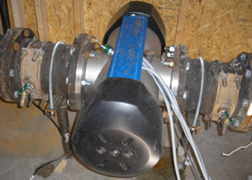Salt Lake City Conducts UV Pilot Study
Public -- Private partnership to study technology to improve drinking water treatment processes.
March 31, 2006
|
Giardia and Crytossporidium cysts are pathogenic and are regulated under the Safe Drinking Water Act. The current method of eliminating these organisms in the treatment process is to filter them out of the water. When the filter bed requires washing, the flow is reversed through the filter bed and the filtered material, including any potential Giardia and Crytosporidum cysts are sent to a clarifier to separate out the solids. The solids are conveyed to drying beds and the supernatant is pumped back to the water treatment plants head works as recycled water
Because Giardia and Crytosporidum cysts are resistant to chlorine disinfection, there is concern that viable organisms can accumulate in the treatment process, and if an opportunity exists, pass through the filter beds into the finished water that is delivered into the distribution system. It should be noted that Giardia and Crytosporidum cysts have never been found in Salt Lake City’s water distribution system, but the study will provide information to ensure this never happens, If UV treatment of backwash water is proven to be successful, this will provide one more barrier in the treatment process to prevent pathogens from entering the drinking water supply. The data from the pilot study will be shared with the drinking water profession.
The pilot study work plan has two purposes: The first is to evaluate the efficiency of UV disinfection in a backwash water return application for inactivation of various microbial contaminants including cryptosporidium, aerobic spores, HPC, total coliform and E. coli as the microbial parameters. The second purpose is to determine the operational procedures and limitations of this application as opposed to UV disinfection in finished water, which is the usual application for UV using the same microbial parameters.
Sampling began on January 23, 2006 and will continue for one year to capture data during seasonal variations.
For futher information about this pilot study email Florence Reynold: florence.reynolds@ci.slc.ut.us or call at 1-(801) 483-6864
